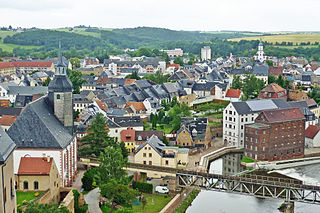
Saxony, officially the Free State of Saxony, is a landlocked state of Germany, bordering the states of Brandenburg, Saxony-Anhalt, Thuringia, Bavaria, as well as the countries of Poland and the Czech Republic. Its capital is Dresden, and its largest city is Leipzig. Saxony is the tenth largest of Germany's sixteen states, with an area of 18,413 square kilometres (7,109 sq mi), and the sixth most populous, with more than 4 million inhabitants.

Dresden is the capital city of the German state of Saxony and its second most populous city after Leipzig. It is the 12th most populous city of Germany, the fourth largest by area, and the third most populous city in the area of former East Germany, after Berlin and Leipzig. Dresden's urban area comprises the towns of Freital, Pirna, Radebeul, Meissen, Coswig, Radeberg and Heidenau and has around 790,000 inhabitants. The Dresden metropolitan area has approximately 1.34 million inhabitants.

A Regierungsbezirk means "governmental district" and is a type of administrative division in Germany. Currently, four of sixteen Bundesländer are split into Regierungsbezirke. Beneath these are rural and urban districts.

Lusatia is a historical region in Central Europe, split between Germany and Poland. Lusatia stretches from the Bóbr and Kwisa rivers in the east to the Pulsnitz and Black Elster rivers in the west, and is located within the German states of Saxony and Brandenburg as well as in the Polish voivodeships of Lower Silesia and Lubusz. Lusatia's central rivers are the Spree and the Lusatian Neisse, which constitutes the border between Germany and Poland. The Lusatian Mountains, separate Lusatia from Bohemia in the south. Lusatia is traditionally divided into Upper Lusatia and Lower Lusatia.

John was King of Saxony from 9 August 1854 until his death in 1873. He was a member of the House of Wettin. During his reign, Saxony became a part of the German Empire.

Saxon Switzerland is a hilly climbing area and national park in the Elbe Sandstone Mountains. It is located around the Elbe valley south-east of Dresden in Saxony, Germany, adjoining Bohemian Switzerland in the Czech Republic. Together with the Czech part, the region is known as Saxon-Bohemian Switzerland.

The Saxon State and University Library Dresden, abbreviated SLUB Dresden, is located in Dresden, Germany. It is both the regional library for the German State of Saxony as well as the academic library for the Dresden University of Technology. It was created in 1996 through the merger of the Saxon State Library (SLB) and the University Library Dresden (UB). The seemingly redundant name is to show that the library brings both these institutional traditions together.

Rochlitz is a major district town in the district of Mittelsachsen, in Saxony, Germany. Rochlitz is the head of the "municipal partnership Rochlitz" with its other members being the municipalities of Königsfeld, Seelitz and Zettlitz.

The Electorate of Saxony, also known as Electoral Saxony, was a territory of the Holy Roman Empire from 1356–1806. Its territory included the areas around the cities of Dresden, Leipzig and Chemnitz.

Prince Albert Joseph Maria Franz-Xaver of Saxony, Duke of Saxony, Margrave of Meissen was the head of the Royal House of Saxony and a German historian. The fourth child and youngest son of Friedrich Christian, Margrave of Meissen and his wife Princess Elisabeth Helene of Thurn and Taxis, he was the younger brother of Maria Emanuel, Margrave of Meissen, who was his predecessor as head of the Royal House of Saxony.

Seelitz is a municipality in the district of Mittelsachsen, in Saxony, Germany. It is part of the administrative partnership Verwaltungsgemeinschaft Rochlitz based in the eponymous town.

The XII Army Corps / XII AK was a Saxon corps level command of the Saxon and German Armies before and during World War I.

Franz Kossmat was an Austrian-German geologist, for twenty years the director of the Geological Survey of Saxony under both the kingdom and the subsequent German Republic.

Cornelius Gustav Gurlitt was a German architect and art historian.

The Royal Saxon State Railways were the state-owned railways operating in the Kingdom of Saxony from 1869 to 1918. From 1918 until their merger into the Deutsche Reichsbahn the title 'Royal' was dropped and they were just called the Saxon State Railways.
The Soviet Republic of Saxony is the name that is sometimes used to refer to a short-lived, unrecognized soviet state that was established in the former Kingdom of Saxony following the collapse of the German Empire at the end of World War I.
The 154th Infantry Division, also known as Commander of the Replacement Troops IV, Division No. 154, 154th Reserve Division, 154th Division and 154th Field Training Division was an infantry division of the German Heer during World War II.

Kreishauptmannschaft Bautzen was a Kreishauptmannschaft or administrative district in the Kingdom of Saxony. It was founded in 1835 and continued under the Free State of Saxony until abolished in 1934.

Kreishauptmannschaft Dresden was a Kreishauptmannschaft or administrative district in the Kingdom of Saxony. It was founded in 1835 and continued under the Free State of Saxony until it was merged with Kreishauptmannschaft Bautzen in 1934 Dresden.
Kreishauptmannschaft Leipzig was a Kreishauptmannschaft or administrative district in the Kingdom of Saxony. Succeeding the Leipziger Kreis of the Electorate of Saxony, it was founded in 1835 and continued under the Free State of Saxony until being renamed the 'Regierungsbezirk Leipzig' in 1939, headed by Erich Teichmann (1882-?) as Regierungspräsident. The Kreishauptmannschaft system was abolished in 1943.















